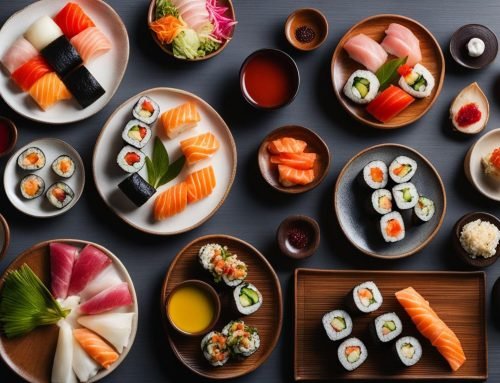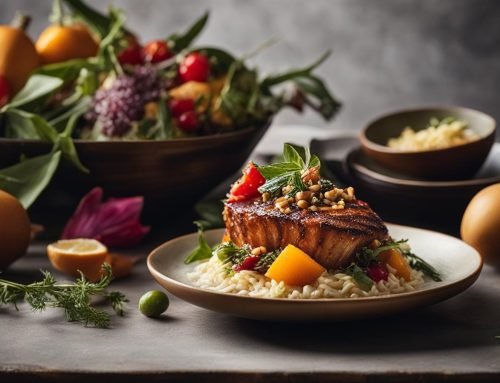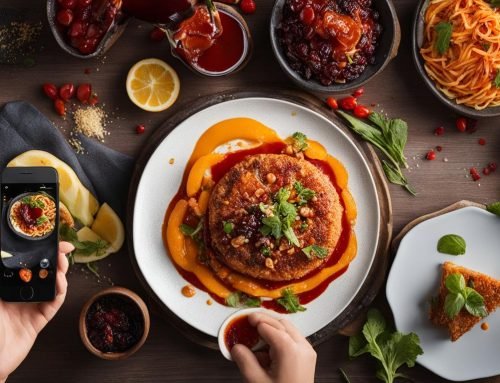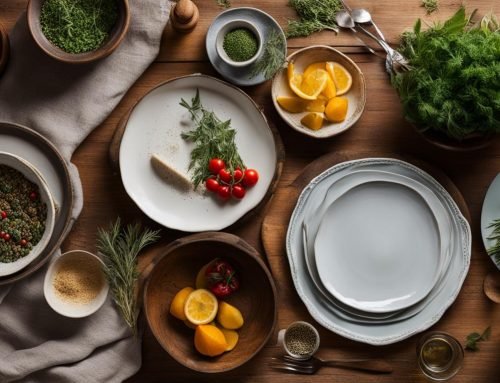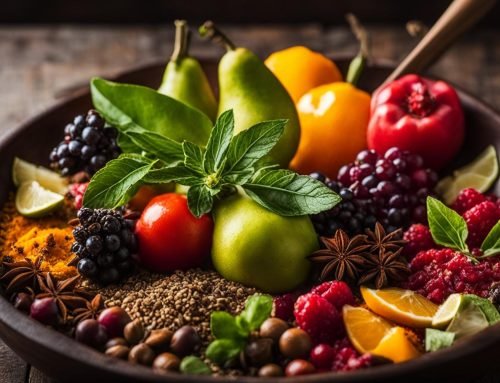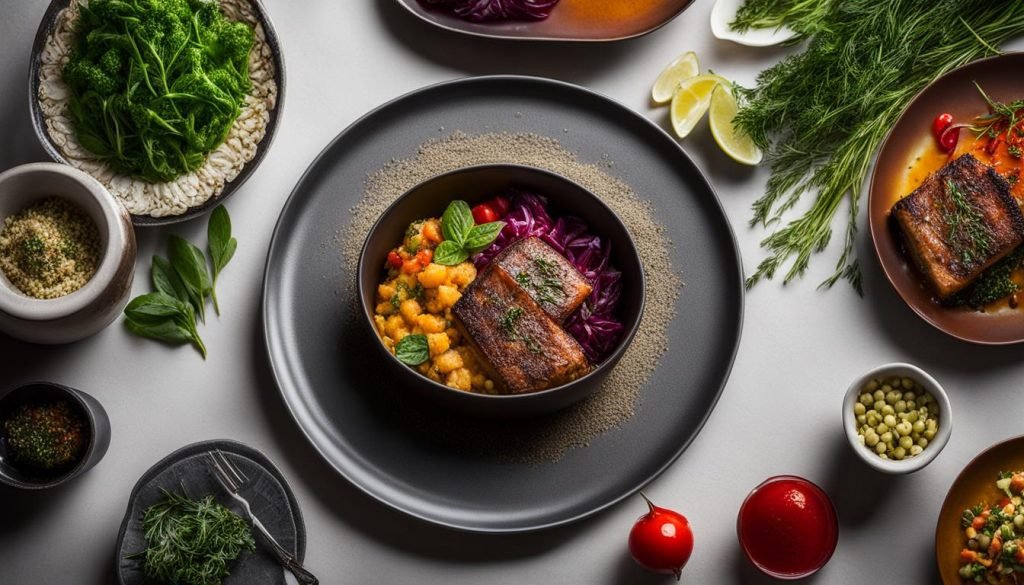
Food photography is a captivating form of visual art that captures the essence and allure of delicious dishes. Whether you’re a professional photographer or a passionate foodie, mastering the art of food photography requires attention to detail and a creative eye. In this article, we will explore valuable tips and techniques to help you capture enticing and mouthwatering food photos that will leave viewers craving for more.
Key Takeaways:
- Learn how to enhance the visual appeal of your food photography.
- Discover effective tips and techniques for capturing mouthwatering shots.
- Explore the fundamentals of food photography, including composition and lighting.
- Understand the importance of styling and presentation in making food look irresistible.
- Learn editing techniques to refine and enhance the visual appeal of your food photos.
The Fundamentals of Food Photography
When it comes to food photography, mastering the fundamentals is key to capturing stunning images that make mouths water. Understanding composition, lighting, styling, and presentation is essential to create visually pleasing photos that do justice to the delicious dishes you capture.
First and foremost, composition plays a vital role in guiding the viewer’s eye and conveying the story of the dish. By considering the placement of the main subject, experimenting with angles, and utilizing techniques like the rule of thirds, you can create balanced and captivating compositions that draw the viewer in.
Lighting is another crucial aspect. Natural light is often the best choice for food photography, as it enhances the colors and textures of the food. Soft, diffused lighting can create a warm and inviting atmosphere in your images. By understanding how to use natural light effectively, you can elevate the overall mood and style of your food photography.
In addition to composition and lighting, styling and presentation are essential for making food look irresistible in photos. Paying attention to details, selecting props and garnishes, and creating a cohesive theme can enhance the visual appeal of the food. Cleanliness and tidiness also play a significant role, as a well-presented dish can have a powerful impact on the viewer.
Summary:
- Mastering the fundamentals of food photography is crucial to capturing stunning images.
- Composition, lighting, styling, and presentation are key elements to consider.
- Experiment with composition techniques like the rule of thirds and angles to create visually captivating compositions.
- Utilize natural light effectively to enhance the colors and textures of the food.
- Pay attention to styling and presentation details to make the food look irresistible.
- Cleanliness and tidiness are important for enhancing the visual impact of your photos.
By focusing on these fundamental aspects, you can elevate your food photography skills and create images that are not only visually appealing but also make viewers crave for a taste of the delicious dishes you capture.
Composition: Telling a Delicious Story
When it comes to food photography, composition is key in capturing the essence of a dish and telling a delicious story. By carefully selecting backdrops, props, and arranging the main subject, you can create visually balanced and captivating compositions that leave viewers craving for more.
One important composition technique to consider is the rule of thirds. Imagine dividing your frame into a grid with nine equal sections and placing the main subject along these lines or at the intersections. This technique adds visual interest and draws the viewer’s eye to the focal point of the image.
Experimenting with different angles can also enhance your compositions. Rather than shooting straight on, try taking photos from above, at a 45-degree angle, or even from a low perspective. Each angle offers a unique perspective and can create dynamic compositions that showcase the food from an interesting viewpoint.
Experimenting with Props and Placement
Props and placement play a crucial role in food photography composition. Choosing the right props, such as cutlery, napkins, or ingredients related to the dish, can add depth and context to your photo. Additionally, consider how the placement of these props affects the overall composition. For example, placing a fork or spoon diagonally across the frame can lead the viewer’s eye towards the main subject.
- Consider the balance of colors and textures in your composition. A variety of colors and textures can create visual interest and make the food look more appetizing.
- Don’t be afraid to experiment with negative space. Leaving empty areas in your composition can help emphasize the main subject and create a sense of elegance.
- Keep in mind the overall mood and atmosphere you want to convey. The composition should align with the style and story you want to tell through your food photography.
By understanding the importance of composition in food photography and exploring various techniques, you can create visually appealing images that tell a mouthwatering story. So, grab your camera, arrange the props, and start composing your next delectable shot.
Mastering Lighting for Mouthwatering Shots
When it comes to food photography, lighting is a fundamental element that can make or break your shots. Natural light is often the best choice, as it brings out the true colors and textures of the food, making it look more appetizing. Look for a well-lit area near a window or a spot where indirect sunlight streams in. Avoid harsh overhead lighting as it can create unflattering shadows. Instead, opt for soft, diffused light that gently illuminates your subject.
One technique to enhance the quality of natural light is to use reflectors or diffusers. Reflectors bounce light back onto the food, reducing shadows and adding a soft glow. You can use white foam boards, aluminum foil, or even a piece of white fabric as reflectors. Diffusers, on the other hand, soften harsh light by spreading it evenly. You can create a DIY diffuser using a white shower curtain or a sheer white fabric stretched over a frame.
Experimenting with different angles and directions of light can also create varied effects. Side lighting can add depth and texture, while backlighting can create a beautiful halo effect around the food. Play around with the position of your subject and observe how the light interacts with it. Remember to take test shots and adjust your setup as needed to achieve the desired look.
Additional Tips for Lighting in Food Photography
- Avoid using direct flash as it can create harsh highlights and unattractive reflections.
- Consider using artificial lights, such as continuous LED panels or strobes, for more control over the lighting setup.
- Use a white bounce card or reflector opposite the light source to fill in shadows and create a more balanced exposure.
- Adjust your camera settings accordingly to match the lighting conditions. Experiment with different white balance settings to achieve accurate colors.
Remember, lighting is the key to capturing mouthwatering shots. Take the time to experiment with natural light, reflectors, and diffusers to find the perfect lighting setup for your food photography.
Styling and Presentation: Making Food Look Irresistible
When it comes to food photography, styling and presentation are essential elements that can make your dishes look absolutely irresistible. By paying attention to details and focusing on freshness and visual vibrancy, you can create images that truly showcase the beauty of the food. Here are some tips and ideas to help you style and present your dishes for mouthwatering food photos:
- Choose the right props: Selecting the appropriate props can enhance the overall theme and mood of your food photos. Consider using utensils, tableware, and linens that complement the colors and textures of the dish.
- Add garnishes and textures: Sprinkle some fresh herbs, seeds, or spices on top of your dish to add visual interest and depth. You can also experiment with different textures, such as adding a crunchy element or a creamy drizzle, to make the food more appealing.
- Create a cohesive theme: To create a harmonious composition, think about the overall theme or story you want to convey through your food photos. Consider the colors, textures, and shapes of the ingredients and props to ensure they work well together.
Remember, cleanliness and tidiness are crucial in food photography. Keep your surfaces clean, wipe off any drips or smudges, and ensure that the presentation of the dish is neat and appetizing. By following these styling and presentation tips, you can make your food look absolutely irresistible in your photos.
Exploring Perspectives and Depth of Field
When it comes to food photography, experimenting with perspectives and depth of field can take your images to the next level. By exploring different angles and utilizing shallow depth of field, you can create unique and captivating compositions that draw the viewer’s attention. Here are some tips to help you explore perspectives and depth of field in your food photography:
1. Change Your Perspective
Don’t be afraid to get creative with your angles. Instead of shooting from the typical top-down perspective, try shooting from various angles such as a 45-degree angle or even from below the plate. Each angle creates a different visual story and adds interest to your composition.
2. Play with Depth of Field
Controlling the depth of field allows you to highlight the most important elements of the dish while creating a beautiful, blurred background. To achieve a shallow depth of field, use a wide aperture (small f-stop number) and focus on the main subject. This technique adds depth and draws attention to the details you want to showcase.
“By exploring different angles and utilizing shallow depth of field, you can create unique and captivating compositions.”
3. Experiment with Props and Backgrounds
Props and backgrounds can significantly influence the perspective and depth of field in your food photos. Try using props that create depth and lead the viewer’s eye towards the main subject. Additionally, choose backgrounds that complement the colors and textures of the dish, adding visual interest to your composition.
By exploring perspectives and depth of field, you can add depth and visual interest to your food photos. Remember to experiment, have fun, and find the angles and depths that best showcase the essence of the dish you’re capturing. The possibilities are endless, so don’t be afraid to push the boundaries of your creativity to create stunning and mouthwatering images.
Enhancing Your Food Photos with Editing
Once you have captured your mouthwatering food photos, the next step is to enhance them through editing. Editing allows you to refine and polish your images, bringing out the best in your food photography. Here are some tips to help you elevate your food photos using editing techniques:
- Adjust exposure and white balance: Play around with exposure and white balance to ensure your image has a balanced and natural look. Correct any overexposed or underexposed areas and adjust the color temperature to accurately represent the colors of the food.
- Enhance colors and contrast: Use editing tools to make the colors in your food photos pop. Enhance the vibrancy of the food’s natural hues and increase the contrast to add depth and visual interest to the image.
- Sharpen selectively: Sharpening can help bring out the details in your food photos, but be careful not to overdo it. Use selective sharpening techniques to sharpen specific areas of the image, such as the food itself, while keeping other elements soft and natural.
“Editing allows you to refine and polish your images, bringing out the best in your food photography.”
When editing your food photos, it’s important to strike a balance between enhancing the image and preserving the authenticity of the food. Avoid over-editing, which can make the food look artificial or unappetizing. Remember, the goal is to showcase the delicious details of the dish and leave viewers craving for more.
Preserving Authenticity Through Editing
While editing can enhance the visual appeal of your food photos, it’s crucial to maintain the authenticity of the food. Here are some tips to preserve the natural look of your dishes:
- Avoid excessive filters: Overusing filters can alter the colors and textures of the food, making it appear unrealistic. Opt for subtle adjustments instead to maintain the integrity of the dish.
- Retouch with care: If there are any imperfections or blemishes on the food, retouch them lightly and judiciously. Remember that the aim is to present the food in its best light without distorting its appearance.
- Keep it clean: Pay attention to any distracting elements in the frame, such as crumbs or smudges. Use cloning or healing tools to clean up these areas while preserving the overall look and feel of the dish.
By applying these editing techniques and preserving the authenticity of the food, you can create visually striking and visually delicious food photos that truly capture the essence of the dish.
Conclusion
Mastering the art of food photography is a journey that requires passion, practice, and attention to detail. By implementing the tips and techniques shared in this article, you can elevate your food photography skills and capture the essence of delicious dishes in a visually enticing way.
Remember that composition, lighting, styling, and presentation are the key fundamentals that contribute to creating mouthwatering food photos. Experiment with different angles, perspectives, and depths of field to add depth and visual interest to your compositions. Don’t forget to leverage natural light and post-processing techniques to enhance the colors, textures, and overall mood of your images.
As you continue to pursue food photography, don’t be afraid to push the boundaries of your creativity and develop your own unique style. Practice regularly, be patient with yourself, and constantly seek inspiration to further refine your technique. With dedication and perseverance, you can capture captivating food photos that engage and delight your audience.
So, grab your camera, plate up your favorite dish, and embark on a journey of capturing mouthwatering moments through the lens. Happy shooting!
FAQ
What are the fundamentals of food photography?
The fundamentals of food photography include composition, lighting, styling, and presentation.
How can I create visually balanced and engaging compositions in food photography?
You can achieve visually balanced and engaging compositions by selecting appropriate backdrops, props, and focusing on the placement of the main subject. Techniques such as the rule of thirds and experimenting with angles can also help create captivating narratives.
What is the role of lighting in food photography?
Lighting is a key element in food photography. Natural light is often the best choice to achieve compelling results. By utilizing soft, diffused light and understanding how it enhances the colors and textures of the food, you can create visually appealing images.
How can I enhance the overall appeal of food in my images?
By prioritizing freshness, visual vibrancy, and paying attention to details in styling and presentation, you can enhance the overall appeal of the food in your images. Selecting props, garnishes, and creating a cohesive theme can make the food look irresistible. Cleanliness and tidiness also play a significant role in enhancing the visual impact of your photos.
How can I add depth and visual interest to my food photos?
Experimenting with perspectives and depth of field can add depth and visual interest to your food photos. By exploring different angles and utilizing shallow depth of field, you can create unique and captivating compositions that draw the viewer’s attention to the most important elements of the dish.
How can I refine and enhance the visual appeal of food photos through editing?
Post-processing is an essential step in food photography to refine and enhance the visual appeal of your images. Through editing, you can adjust exposure, white balance, colors, contrast, and sharpness to create a balanced and visually striking final result. It is important to achieve a natural and realistic look while preserving the authenticity of the food.
How can I improve my food photography skills?
Mastering the art of food photography requires practice, experimentation, and attention to detail. By implementing the tips and techniques discussed in this article, you can elevate your food photography skills and capture the essence of delicious dishes in a visually appealing way. Remember to have fun, be patient, and constantly seek ways to push the limits of your creativity.

